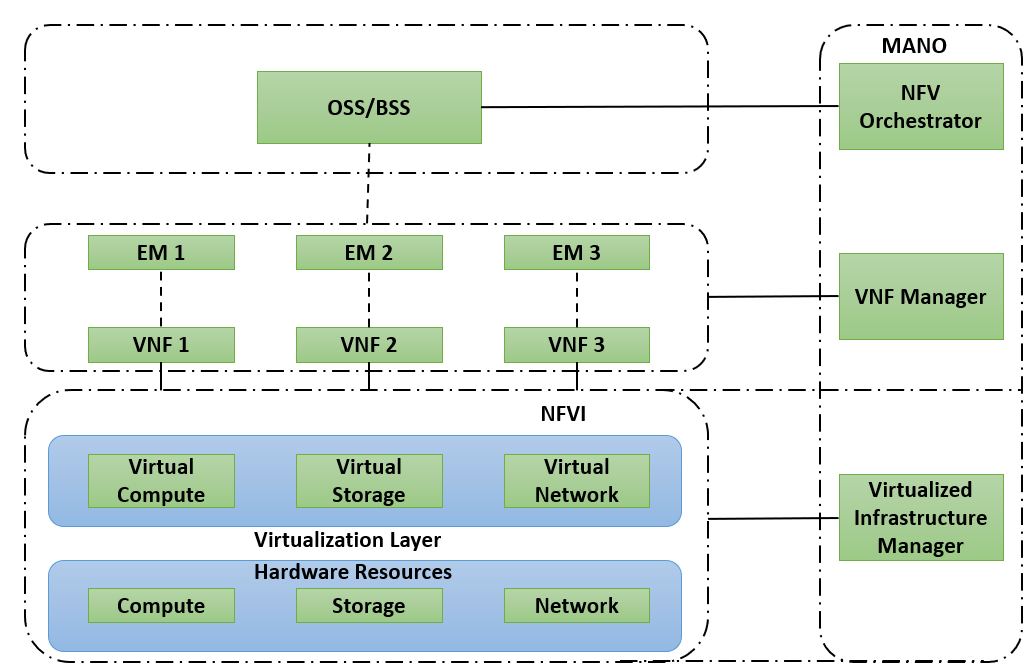Network function virtualization (NFV) is an architectural framework created by the European Telecommunications Standards Institute (ETSI) that defines standards to decouple network functions from proprietary hardware-based appliances and have them run in software on standard x86 servers. It also defines how to manage and orchestrate the network functions. Network function (NF) refers to the function performed by a physical appliance, such as a firewall or a router function. Some of the benefits of NFV are similar to the benefits of server virtualization and cloud environments:
- Reduced capital expenditure (capex) and operational expenditure (opex) through reduced equipment costs and efficiencies in space, power, and cooling
- Faster time to market (TTM) because Virtual Machines and containers are easier to deploy than dedicated hardware appliances
- Improved return on investment (ROI) from new services
- Ability to scale up/out and down/in capacity on demand (elasticity)
- Openness to the virtual appliance market and pure software networking vendors
- Opportunities to test and deploy new innovative services virtually and with lower risk

NFV Infrastructure
Network Functions Virtualization Infrastructure (NFVI) is all the dedicated hardware devices and software components that comprise the platform environment in which virtual network functions (VNFs) are deployed.
Virtual Network Functions
A virtualized network function (VNF), as its name implies, is the virtual or software version of an NF, and it typically runs on a hypervisor as a Virtual Machine. Virtualized Network Functions are commonly used for Layer 4 through Layer 7 functions, such as those provided by load balancers (LBs) and application delivery controllers (ADCs), firewalls, intrusion detection systems (IDSs), and WAN optimization appliances. However, they are not limited to Layer 4 through Layer 7 functions; they can also perform lower-level Layer 2 and Layer 3 functions, such as those provided by routers and switches. Some examples of Cisco VNFs include the following:
- Cisco Cloud Services Router 1000V (CSR 1000V)
- Cisco Cloud Services Platform 2100 (CSP 2100)
- Cisco Integrated Services Virtual Router (ISRv)
- Cisco NextGen Firewall Virtual Appliance (NGFWv)
- Cisco Adaptive Security Virtual Appliance (ASAv)
Virtualized Infrastructure Manager
The NFVI Virtualized Infrastructure Manager (VIM) is responsible for managing and controlling the NFVI hardware resources (compute, storage, and network) and the virtualized resources. It is also responsible for the collection of performance measurements and fault information. In addition, it performs lifecycle management (setup, maintenance, and teardown) of all NFVI resources as well as VNF service chaining. Service chaining refers to chaining VNFs together to provide an NFV service or solution, as illustrated below.

Element Managers
Element managers (EMs), also known as element management systems (EMSs), are responsible for the functional management of VNFs; in other words, they perform fault, configuration, accounting, performance, and security (FCAPS) functions for VNFs. A single EM can manage one or multiple VNFs, and an EM can also be a VNF.
NFV Management and Orchestration
The NFV orchestrator is responsible for creating, maintaining, and tearing down VNF network services. If multiple VNFs are part of a network service, the NFV orchestrator enables the creation of an end-to-end network service over multiple VNFs. The VNF manager manages the lifecycle of one or multiple VNFs as well as FCAPS for the virtual components of a VNF. The NFV orchestrator and VNF manager together are known as NFV management and orchestration (MANO).
Operations Support System (OSS)/Business Support System (BSS)
OSS is a platform typically operated by the service provider (SP) and large enterprise networks to support all their network systems and services. The OSS can assist them in maintaining network inventory, provisioning new services, configuring network devices, and resolving network issues. For SPs, OSS typically operates in tandem with BSS to improve the overall customer experience. BSS is a combination of product management, customer management, revenue management (billing), and order management systems that are used to run the SP’s business operations.
Download our Free CCNA Study Guide PDF for complete notes on all the CCNA 200-301 exam topics in one book.
We recommend the Cisco CCNA Gold Bootcamp as your main CCNA training course. It’s the highest rated Cisco course online with an average rating of 4.8 from over 30,000 public reviews and is the gold standard in CCNA training:
